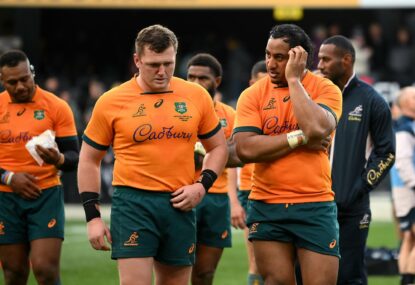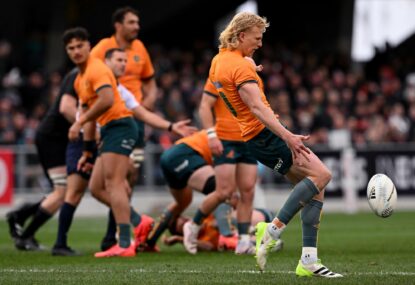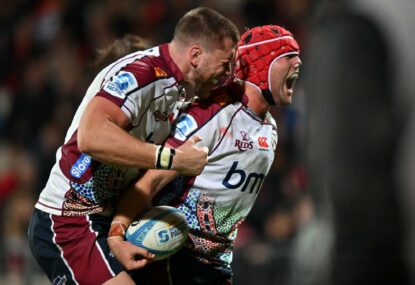It is appropriate and exciting for the Wallabies to be wearing a jersey with a special indigenous motif in the third Bledisloe Test tonight, but it is unlikely that this will attract Aboriginal players to the code in increasing numbers.
If the experience of Aboriginal players on the North Coast of NSW in the 1890s, when rugby began in that region, is representative of other regions, then it is no wonder they have not embraced the code. Indigenous people certainly did play rugby but they were not made to feel welcome.
One such player, Wurrah (L Larkin) was one of the best players for Lismore club the Pirates in a match against Ballina Excelsior club in 1895. But next season, the Rous Rovers club refused to play against him and the newly formed Lismore club resolved they would neither play with or against Aboriginals. Rugby columnist in the Northern Star newspaper, Maori commented on this overt racism:
I have at different times heard feeble specimens of humanity raising their voices against the inclusion of this robust young aboriginal. They say they are not afraid of his grit and fleetness of foot on the field. Oh, dear, no they angrily object because his pelt does not happen to be the same colour as their own. It may be darker, but I doubt if it is half as thick as that of some of them.
Larkin’s name appeared frequently in the list of starters for professional footraces, popular at the time, but, often given a big handicap, he does not seem to have had much success.
However, his rugby career did not end immediately.
Symbolically, the first rugby side to travel on the recently completed railway from the Richmond River to the Clarence River was a team of Aboriginal footballers. It was a novel experience for most of the team who had no previous experience of train travel.
The Richmond team, captained by Albert Larkin, included Wurrah or L Larkin, James Capp, George Larkin, Jemmy Woodgem, Charlie Keber, Jack Bungar, Peel Wilson, King Webster, Bob Chumbibil, Billy Ferguson and George Thompson left Lismore for Grafton in May, 1906. They were joined at Casino by Arthur Graydon, Jack Roberts and Jack Ray.
At Koolkan, the manager of the Home for Aborigines at Grafton met them and showed them to their quarters. Messengers were sent to round up a number of the Clarence Aboriginals who were away working downriver at Ulmarra.
Having gained permission to play on Fisher Park, they had to erect goal posts because the season had not started and the ground was not prepared.
Grafton had raised a full team by the time play started about 3:30pm. All played barefooted and many had their shirts torn off in the scrimmages but continued in borrowed vests.
According to the Grafton paper, the Examiner, it was ‘an exciting game.’ Although the home team lost 14-12, ‘they showed the better play, though, as might be expected, not much science was displayed.’ Jack Neville stood out as Grafton’s best player, scoring a number of tries.
The referee, who was co-opted from the crowd, ‘permitted plenty of latitude and did not keep … rigidly to Rugby rules.’
James Capp collected 15 shillings from the spectators to buy the visitors an evening meal and the post-match celebratory dancing continued throughout the night. They left by train early on Thursday morning. Albert Larkin and Capp reported very favourably on the trip expressing thanks to those who subscribed to pay for their fares and also to the railway guards who looked after them.
The return match was played some months later at Lismore with the Richmond team once again successful.
An exciting match between Casino and Lismore Aboriginals in 1906 at the Oval in Lismore, won 11-6 by Lismore, drew praise from the onlookers and the Northern Star reported that ‘the dash put into the play by the contesting teams was much admired and their quickness and accuracy in picking up and handling the leather was a treat to witness.’
Regrettably, Aboriginals were soon after actively discouraged from playing rugby. In 1907, indigenous players were disbarred from playing competition matches on the Clarence, their flair and skills lost to the code for more than 60 years. ‘Full-blooded’ Aboriginals were also prohibited from playing in the Bellinger River competition the same year.
Rugby did not resume on the North Coast after the World War I recess until the late 1960s and by that time, indigenous players were starring in rugby league teams where, largely, they have preferred to stay.
We can applaud and encourage the efforts of the Lloyd McDermott organisation and the occasional recruitment of an individual indigenous player but we must accept that it will take more than a fancy jersey to redress the past injustice done to Aboriginal players.


































































































